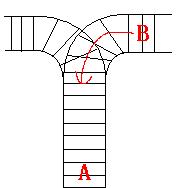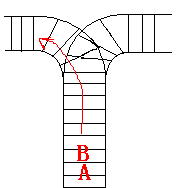#问题
Train Problem I
Time Limit: 2000/1000 MS (Java/Others) Memory Limit: 65536/32768 K (Java/Others)
Total Submission(s): 46047 Accepted Submission(s): 17252
Problem Description
As the new term comes, the Ignatius Train Station is very busy nowadays. A lot of student want to get back to school by train(because the trains in the Ignatius Train Station is the fastest all over the world ^v^). But here comes a problem, there is only one railway where all the trains stop. So all the trains come in from one side and get out from the other side. For this problem, if train A gets into the railway first, and then train B gets into the railway before train A leaves, train A can't leave until train B leaves. The pictures below figure out the problem. Now the problem for you is, there are at most 9 trains in the station, all the trains has an ID(numbered from 1 to n), the trains get into the railway in an order O1, your task is to determine whether the trains can get out in an order O2.


Input
The input contains several test cases. Each test case consists of an integer, the number of trains, and two strings, the order of the trains come in:O1, and the order of the trains leave:O2. The input is terminated by the end of file. More details in the Sample Input.
Output
The output contains a string "No." if you can't exchange O2 to O1, or you should output a line contains "Yes.", and then output your way in exchanging the order(you should output "in" for a train getting into the railway, and "out" for a train getting out of the railway). Print a line contains "FINISH" after each test case. More details in the Sample Output.
Sample Input
3 123 321 3 123 312
Sample Output
Yes. in in in out out out FINISH No. FINISH
Hint
Hint For the first Sample Input, we let train 1 get in, then train 2 and train 3. So now train 3 is at the top of the railway, so train 3 can leave first, then train 2 and train 1. In the second Sample input, we should let train 3 leave first, so we have to let train 1 get in, then train 2 and train 3. Now we can let train 3 leave. But after that we can't let train 1 leave before train 2, because train 2 is at the top of the railway at the moment. So we output "No.".
#分析
这是一个栈的问题,我们有序列A和B,需要将A中所有元素进栈出栈后,变为序列B。如果可以完成,则输出变换步骤,如果不能完成,则输出No.
入栈和出栈的过程可以相间,比如1234就可以变成2134这个序列。
我们设定i和j分别记录入栈,出栈的次数
输入的总元素数量为n,则i和j不会大于n
每个过程为A的一个元素先入栈,然后检查是否与B正在检查的元素相等,若相等,则栈顶元素出栈,B检查点下移,若不等,则A检查点下移,继续下一个元素入栈。
同时我们需要使用一个数组对操作依次记录,下面代码中用op数组来记录,1表示出栈,-1表示入栈。
#AC码
#include<iostream>
#include<stack>
#include<string>
#include<string.h>
using namespace std;
int main()
{
int n;
while(cin>>n)
{
int op[20];
memset(op,0,sizeof(op));
string A,B;
cin>>A>>B;
stack<int> s;
int cn=1;
int i=0;
int j=0;
while(1)
{
if(s.empty()||s.top()!=B[j]-'0') //不能出栈,继续A下一个元素入栈
{
if(i==n) //序列A空,且栈顶元素不满足
break;
s.push(A[i]-'0'); //入栈
i++;
op[cn]=-1;
cn++;
}
else //需出栈,B跳转下一元素
{
j++;
s.pop();
op[cn]=1;
cn++;
if(j==n) //序列B检查完成
break;
}
}
//有一序列为空
if(j==n) //B先为空
{
cout<<"Yes."<<endl;
for(int k=1;k<=cn;k++)
{
if(op[k]==1)
cout<<"out"<<endl;
if(op[k]==-1)
cout<<"in"<<endl;
}
}
else //A先为空
{
cout<<"No."<<endl;
}
cout<<"FINISH"<<endl;
}
return 0;
}






















 157
157

 被折叠的 条评论
为什么被折叠?
被折叠的 条评论
为什么被折叠?








